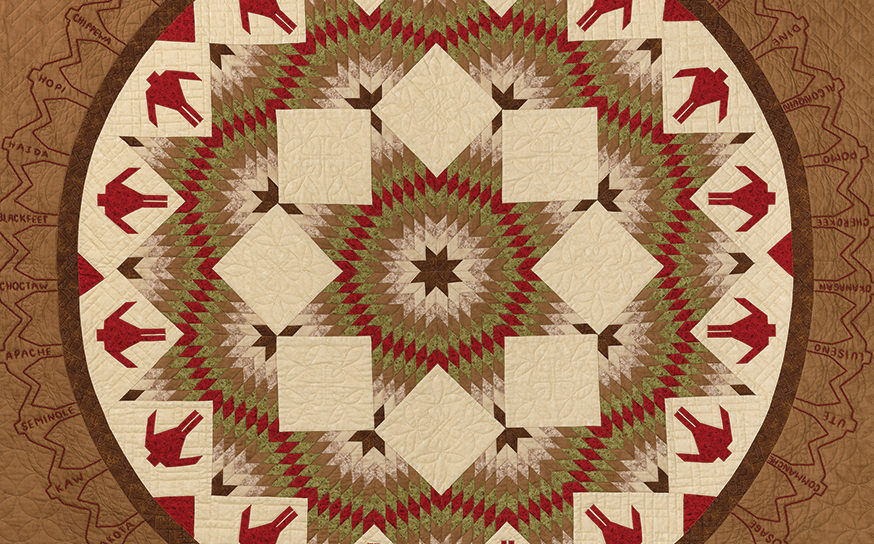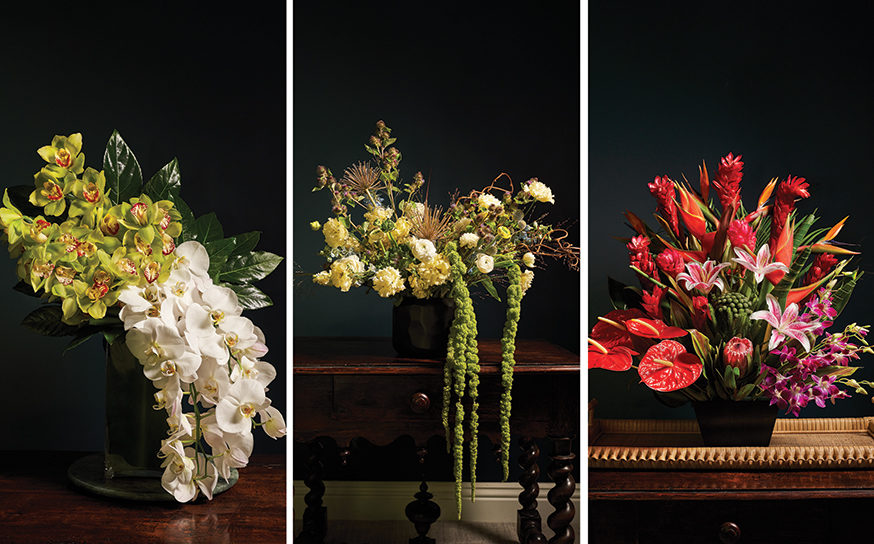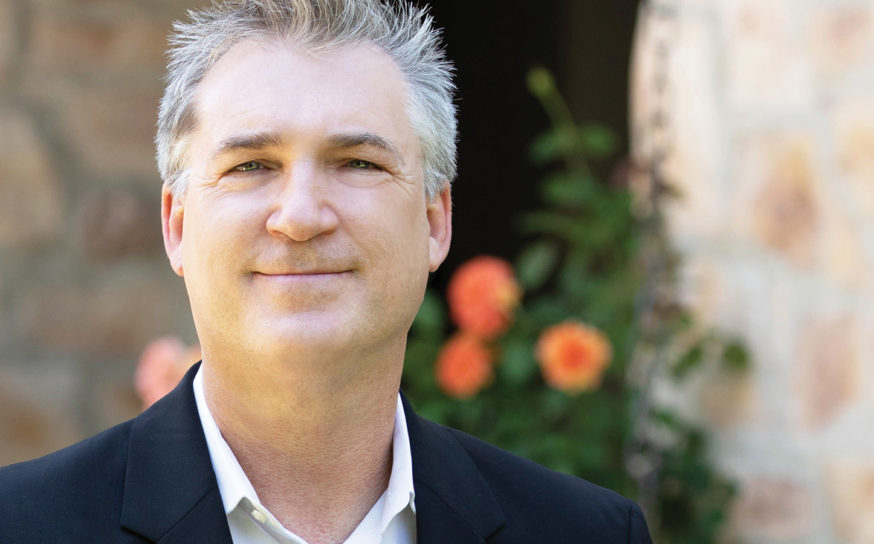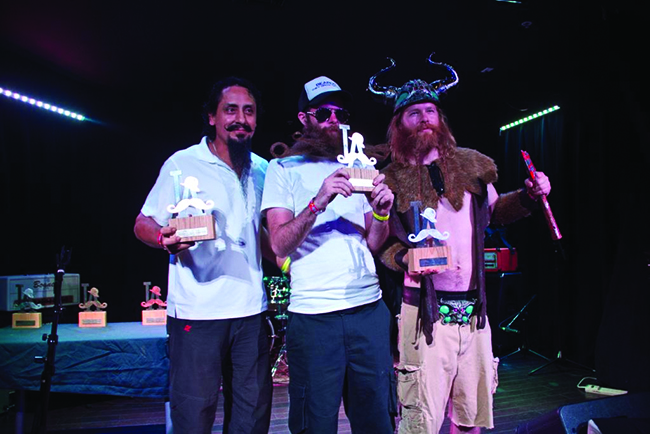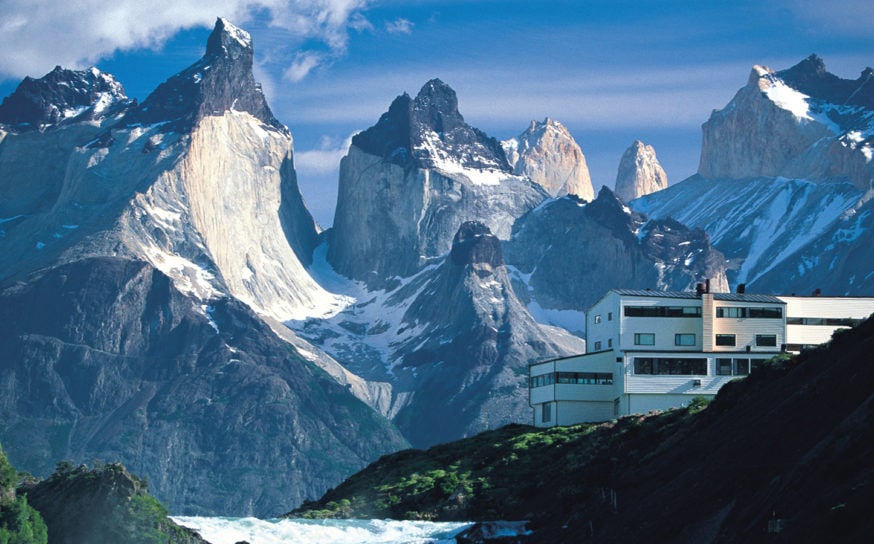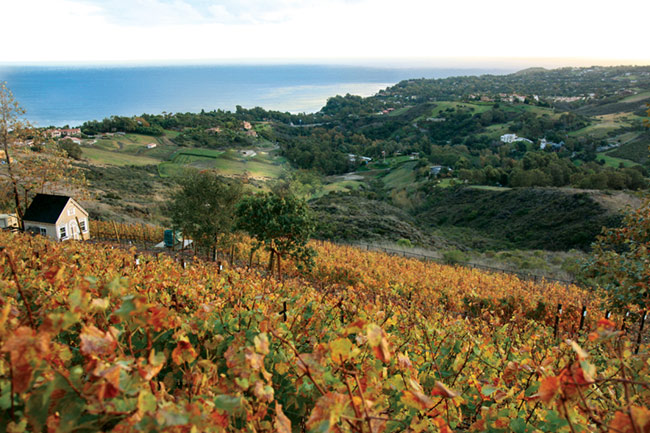
Oceanfront Vino
It started rather serendipitously. A local resident clearing hazardous brush decided to plant grapes in its place. Now, nearly 30 years later, the region’s most acclaimed vintners are raising glasses for the ultimate toast, as Malibu prepares to receive the prestigious AVA designation.
-
CategoryUncategorized
-
Written byTiffany Shinn
We joke that if you’re going to get in the wine business, you better have another job,” laughs Ron Semler, owner of Malibu Family Wines, when asked if winemaking is his sole occupation. “It takes a lot of investment, passion and very hard work.”
Ron, who is among the well-established wine producers who own and grow grapes in Malibu, was one of the first to plant vines at his ranch in 1996. Today there are more than 50 vineyards in the region, each yielding varying varietals and quantity of grapes.
Many Malibu vineyard owners produce wine for personal use. Some remain fairly hands-off and hire professionals to run their farms. But a select group have emerged as serious commercial producers and have established the beach community as a world-class wine region with vintages that have scored medals at the country’s most distinguished competitions.
FIRST CRUSH
While the accolades have only been granted in recent years, grape planting in Malibu can be traced back to the mid-1800s. At the time, LA County was the biggest wine producer in California. And because Malibu’s climate paralleled the Mediterranean—with wet winters and an extremely dry growing season—it became a prime area to harvest grapes.
Prohibition wiped out the wine industry in 1920, with the exception of sacramental wine production, and in the ‘40s the industry shifted to Napa. It wasn’t until several decades later that someone decided to replant grape vines in Malibu.
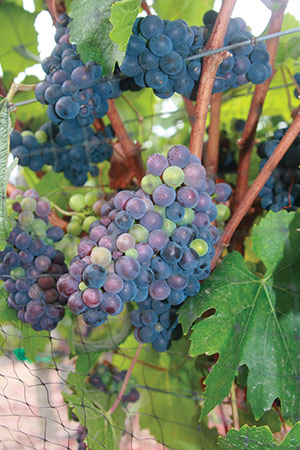
THE TRAILBLAZER
That person was restaurateur Michael McCarty, owner of the Santa Monica institution Michael’s. The idea to plant grapes arose at one of Michael’s parties, after he received a notice from LA County about clearing the brush around his Malibu residence.
Michael, who earned diplomas from France’s Cordon Bleu and Académie du Vin, ran in distinguished circles of culinary innovators, whom he often invited up to his Malibu home. “We had a lot of parties up there,” he chuckles.
And it was there, during a night of revelry, that Michael brought up the issue of the brush to his guests. The group began to throw around thoughts about the space. “And we came up with the idea to plant a vineyard,” he reminisces.
Michael was active in the American Institute of Wine & Food, where he met Richard Graff, the California winemaking pioneer and former owner of Chalone Vineyard. In 1985 Richard and Michael started the long-term process of planting five varietals of grapes at Michael’s home along the coast. Five years later, they harvested their first vintage, and The Malibu Vineyard label was born.
Over the next few years, Michael’s efforts were fruitful—with his vineyard producing between 150 and 200 cases of wine. “We were having a blast with this odd little vineyard overlooking Malibu beach,” he muses. But in 1993 a fire swept Malibu, destroying his home and most of his crop.
When Michael replanted his entire vineyard in 1999, he decided to grow Pinot noir exclusively, based upon the coastal microclimate of his property. Pinot noir grapes flourish in an environment with warmer winters and colder summers.
“It was always my favorite anyway,” Michael laughs. He released about 250 cases of his first vintage from the new vineyard, Rambla Pacifico pinot noir, in 2005.
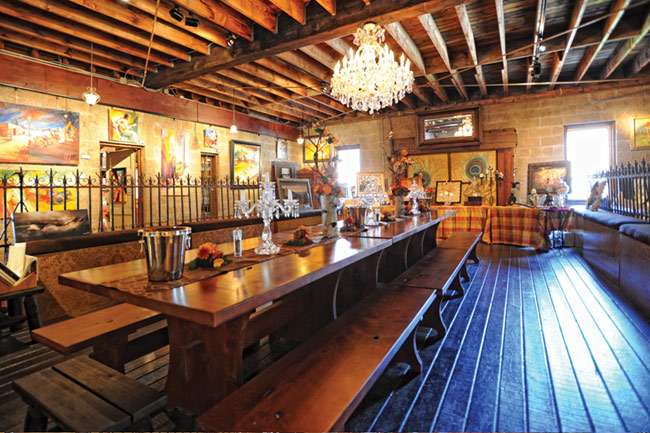
Cornell Winery invites the public to sample wine in a handsome tasting room.
AN INDUSTRY IS BORN
By this point, many other Malibu winemakers were also on the rise. Ron Semler planted grapes in 1996, after a severe freeze wiped out 10,000 avocado trees on his property. He established two vintages: Semler, which came from grapes grown on his estate, and Saddlerock, produced from grapes purchased from other vineyards.
Over the years, he expanded his vineyard to 70 acres and opened a popular tasting room. George Rosenthal, a Hollywood real estate magnate, had also planted 30 acres of vines in Newton Canyon and opened a Rosenthal vineyards tasting room along the bustling Pacific Coast Highway.
GRAPE GROWING 101
Surprisingly, Malibu, known for its magnificent beaches and opulent celebrity homes, is an ideal region for growing grapes. The unique topography and weather conditions contribute to beneficial environmental factors such as volcanic soil, high elevation and diurnal temperature shifts.
With its proximity to the Pacific Ocean, vineyards along the coast are exposed to long afternoons and cooler temperatures—ideal for producing Burgundy wines, such as chardonnay and pinot noir. In the mountains, where vines are exposed to more heat, Bordeaux flourishes, bearing cabernet sauvignon, Syrah and merlot. With such varying microclimates, Malibu generates unique, heterogeneous varietals, each label boasting different flavors.
“That homogenization—where wines lose their identity—can’t take place here,” Tim Skogstrom, owner of Cornell Winery and Tasting Room, explains. In addition to the complex environmental factors, the craggy terrain prohibits the use of machinery, so all grapes need to be picked by hand.
“The vineyards are people’s backyards,” Tim adds. “Their kids play there, so everything is farmed organically.”
Cornell, a charming gem ensconced in the Santa Monica Mountains, is the only local tasting room that sells and features various Malibu labels. Sitting down with Tim on a Saturday afternoon, two Malibu winemakers, Jim Palmer and Elliott Dolin, happen to pass through. They shake hands and share a few laughs.
Jim, a business manager who produces Malibu Vineyards, has just returned from the Ultimate Wine Challenge in New York, where his 2010 cabernet franc was deemed the Chairman’s Trophy winner and scored 91 points, along with his 2010 Syrah and his Meritage blend.
Elliott, a commercial real estate investor, has also had remarkable success with his estate-grown chardonnay, snagging a double gold medal for his 2010 vintage at the popular San Francisco Chronicle wine competition.
Elliott says he entered his vintages into wine competitions to illustrate the quality of Malibu-grown wines and give Malibu a chance to be perceived on the same caliber as more popular grape-growing regions. “You couldn’t wear the number of medals these two have been awarded for their wine,” Tim gestures to Jim and Elliott. They both beam.
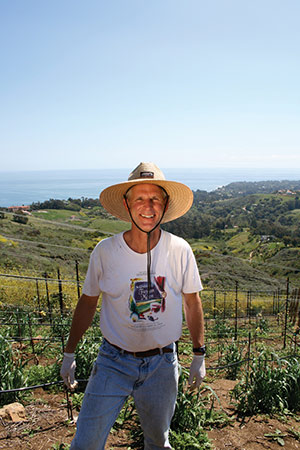
THE A LIST
Jim and Elliott are two of the most ambitious and dedicated small-production commercial winemakers in Malibu, along with Charles Schetter, owner of Malibu Sanity Wines. Charles’ day job is working as president of Hearthstone, a large real estate company. His passion, however, is crafting wine.
He studied his land for an entire year before planting in 2004, ensuring he would choose the best varietals for his property’s microclimate. Since then, he has become one of the most well-respected and lauded winemakers in Malibu and is the first grower in Malibu to be certified in UC Davis’ viticulture and enology program—in which students study grape-harvesting and winemaking.
Charles’ vineyard, nestled between two canyons, is a striking stretch of land facing southwest toward the ocean. “We made a decision the way our wine would taste the day we planted grapes,” he says, noting his single vineyard production—meaning his wines are produced with grapes exclusively grown in his vineyard. He doesn’t blend with other grapes.
Charles Schetter of Malibu Sanity Wines on his property
After assessing the terroir—the unique geology, soil and climate that defines his vineyard—he planted chardonnay and pinot noir. He then decided to process them like white Burgundy, rested in oak barrels imported from France and fermented in stainless steel barrels.
“They say the best fertilizer is the owner’s footsteps,” Charles explains while weaving through his pristine vineyard on a Sunday afternoon. He plucks a pinot noir grape off a clump—unpolished, purple gems—and chews on it thoughtfully before spitting out the seeds and skin. “I try to touch every vine every week.”
He has installed two weather stations to monitor Sanity vineyard. The stations track the sunlight, heat, rain, moisture and evapotranspiration, and the father of four wakes up at 4:30 a.m. daily to check on his vines.
“This isn’t an I Love Lucy situation,” he grins. “There is no joking around on harvest days in September. I vehemently reject the idea that producing wine is a hobby, because it implies it’s casual.”
Charles produces 250 cases annually, half chardonnay and half pinot noir. Every year he sells out. So do Jim Palmer and Elliott Dolin.
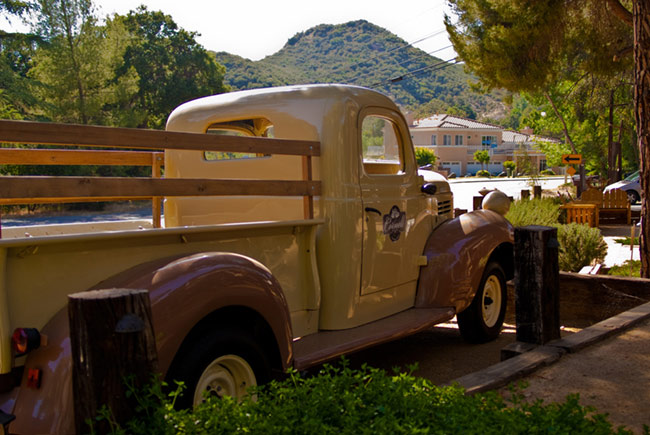
An antique truck, boasting the Cornell logo, greets viisitors.
THE HURDLES
Despite its beneficial climate conditions, growing vines in Malibu is not without challenges. For the past two and a half years vineyard owners have been petitioning to establish Malibu as an American Viticultural Area (AVA)—a prestigious designation that would recognize the area as a distinct growing region that can grow world-class wines. The approval was granted in September and so, beginning in March, producers will be able to put “Malibu Coast” on the label instead of California or Los Angeles.
Furthermore, there are no wineries in Malibu, due to old prohibition laws. Growers are required to transport their grapes to “custom crush” facilities at nearby locations, such as Camarillo or Westlake Village, where their crop is fermented and processed into wine.
Then there are pests–raccoons, skunks, foxes, gophers, deer and coyotes—which gnaw on the vines and drip irrigation lines. The smaller vermin are trapped and relocated on a regular basis. Additionally, each vine must be netted to protect the grapes from birds.
And finally, there is disease. Many winemakers lose a substantial percentage of their crop each year due to botrytis rot and powdery mildew that strikes before harvesting.
THE MONEY TRAIL
So can making wine be profitable? “To be an economically viable vineyard is to break even,” Charles Schetter confides.
Malibu Sanity, Malibu Vineyards and Dolin Malibu Estate Vineyards have all found a place on wine lists at Los Angeles’ most prestigious restaurants, including Wolfgang Puck’s Spago, Thomas Keller’s Bouchon Bistro, Geoffrey’s Malibu and the new Larry Ellison enterprise, Nikita. Selling wine to a restaurant, however, is more about exposure than profit, unless the vintage is served by the glass, where a single serving can cover the wholesale cost of the entire bottle.
Additionally, winemaking itself is a long-term investment. It takes three to four years after planting to yield the first vintage, and after growing and harvesting, the wine still needs to be processed and barreled. “You have to be patient and not rush to get your wines outs,” Elliott Dolin remarks. He ages his reds for 18 months and his whites for 12 months.
For most wine makers, though, it’s not about economic gain. Regardless of profit, they continue to harvest each year, driven by their love of the process. “I have a day job, and I also have four children that are 10 and under,” shares Charles. “But I’ll get home from work, and I’ll take a couple of kids to check the traps with me. If you have a passion for it, you’ll find a way to make it work.”
“I’m standing outside here now, looking at all of this,” Michael McCarty remarks while surveying his vineyard. He lets out a sigh that’s somewhere between a laugh and a gasp. “It’s stunning.”
On a cool summer day, between sips of a gorgeous, light glass of Sanity pinot, Charles smiles when asked about the best part of drinking that very first bottle of each year’s vintage. He leads me to two blue wooden chairs at the edge of his property, which overlooks the glimmering Pacific.
“It’s the blue chair special,” he nods. “You’ll look at Paradise Cove out over the vineyard, and there’s a moment of quiet appreciation of the vineyard and what it gives. There’s a moment of ‘sanity.’ That’s the best moment.”
I gaze out into the ocean and take a sip of his pinot. It tastes like every vine has been touched by the owner’s hand.
The best moment, indeed.






